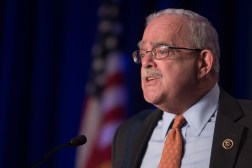DOD CIO’s lowest performance mark? Data centers, he says.

When it comes to closing down data centers, Defense Chief Information Officer Terry Halvorsen is the first to say the department is behind where it should be.
And as he spoke to reporters in the Pentagon on Wednesday for what was likely his last roundtable, he said “it’s the one area that if you asked me where I give myself the lowest mark, not the team but myself, because in the end it’s my responsibility, is data centers.”
Halvorsen also said on Wednesday he plans to leave his role as the Pentagon’s IT chief at the end of February.
“We did not get as many closed as I would have liked to get closed,” Halvorsen said of data centers, but he did note that the department is making some progress.
For example, the department’s data center closure team just completed its first trip — to Charleston, South Carolina — he said Wednesday. They are headed to San Antonio next, Halvorsen said.
“They’ve come back with a good plan to how to close some data centers in Charleston, keep some things there open based on a mission effectiveness site using industry best practices and standards from the beginning on how best to operate the data center,” Halvorsen said. “We’ll do the same thing in San Antonio.”
He added: “As we are keeping some things the same geographic area and consolidating within geographic areas, I think that will make it a little bit more palatable to everybody that needs to support that to get it done.”
In August 2016, Deputy CIO for Information Enterprise Randall Conway first announced the new team would review the 25-to-50 least efficient DOD data centers.
[Read more: DOD CIO outlines plans for data center closure team]
The team features subject matter experts from each the military services.
“All of the services are represented — they’re represented from their operational committee, they all got to pick the people they wanted to be in this from their technical community,” he said, noting that “it is being led by the DOD CIO data center team plus my senior leadership.”
DOD is far behind in its administration-mandated data center closure goals, a fact that Halvorsen did not shy away from in November 2016 at a press conference the day after the closure team kicked off its work. A March 2016 inspector general’s report found the department was on course to miss its goal next year for data center closures and closed less than half its targeted goal up to that point.
[Read more: DOD missing data center closure goals — audit]
“We are behind in data center closure … I have got to drive that better,” Halvorsen said at the time. “That’s costing us money that we could spend today in a more direct use.”
Army Secretary Eric Fanning recently laid out an explicit plan for the Army to achieve its data center closure and consolidation goals by 2018 — an effort that has otherwise made little progress in the past two years.
[Read more: Likely to miss data center goals, Army issues stringent new plan for closures]
And Halvorsen said on Wednesday he thought Fanning’s memo would help speed things up.
“The Army is absolutely using the same practices, best business practices, they’re looking at cost, mission,” Halvorsen said. “And yes, I have hope that that will also speed the process up.”
Halvorsen explained that while the Pentagon’s data center closure team is focusing primarily on mixed data centers, owned by multiple services, this allows the Army to have a strategic plan for its own data centers.
“What the Army is doing, I think it makes sense, is taking those best practices and principles and applying it to Army-specific areas where they can say, ‘hey we have these Army data centers here, we can reduce that size,’” Halvorsen said.
He also said that, “Any time I think you get the senior leadership of any of the services involved, I think that’s a really good thing. I have worked with Secretary Fanning in the past, he really does understand this and I really do believe that that memo will help accelerate the Army’s plan.”






